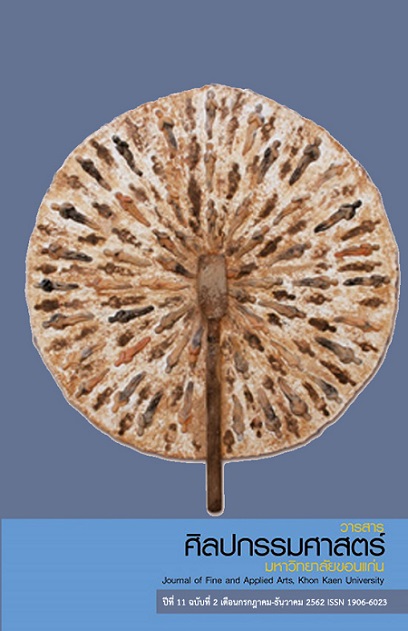Choreography of Folk Performance of Yaring Palace, Pattani Province
Main Article Content
Abstract
This research aimed to study the inheritance, element, dance posture and choreography of performance of Yaring Palace, Pattani Province. The study was conducted using the documentary study, interviews, observations and training on major dance postures from folk artists in Pattani Province.
The research revealed that performance of Yaring Palace in Pattani Province was composed of dance style with accompanying melody. It has been inherited as artistic heritage of Thailand since the reign of King Rama I the Great and well-known during the times of Phraya Pipit SenamatSrisuraSongkram. The folk dance consisted of the performance of Rongeng, Joget Pahang, and TariKipas show. Later, in the year 1951, KhunCharuWisetSueksakorn, then Pattani District Education Chief, initiated the restoration for performance of Yaring Palace of Pattani to become the tradition that remains until present. The main element of performance of Yaring Place is the use of both folk music and western musical instruments with Malay melody. A minimum pair of male and female performer dressed in Malay court style forms. Each song is accompanied by a dance style. Rongeng performance features eight songs with 16 dance moves, whereas Joget Pahang features three songs with 18 dance moves and TariKipas features one song with 11 dance moves. Choreography of performance of Yaring Palace comprises 1) costumes for performance: Male performers wear Baju Melayu (Malay shirt) while female performers wear Kebaya, Banong dresses utilizing Kerongsang (a pin instead of a button), a low bun hairdo with flowers attached to it. 2) The performance starts and ends with a move showing respect to the audience or with a "salam" phrase. 3) The performers move by touching the foot on the floor and the footstep movements in tune with the rhythm of the gong. 4) There are six specific choreographic movements: closed hand, foot touch, foot twist, foot tramping, body rotation and moving in opposite direction. Particularly unique is the movement of the couple to follow the dance partner to the right and left. The choreography of Yaring Palace, Pattani Province truly reflects the wisdom of local performing art of the people in Yaring community and the people in Pattani. In general, the art form which should be maintained and the knowledge about it be shared so that it will remain with the community and the nation.
Article Details
Content and information in articles published in the Journal of Fine and Applied Arts of Khon Kaen University is regarded as the opinion and sole responsibility of the author(s) directly; therefore, editors are not obliged to agree to or share any responsibility with regard to the content and information that appears within these articles.
All articles, information, content, image, etc. that have been published in the Journal of Fine and Applied Arts of Khon Kaen University is the copyright of the Journal of Fine and Appllied Arts of Khon Kaen University. Any person or organization who wishes to distribute all or parts of the articles for further dissemination or other usage must first receive permission from the Journal of Fine and Applied Arts of Khon Kaen University before proceeding to do so.
References
ฐิติศักดิ์ เวชกามา. (2553). แนวคิด ทฤษฎี วัฒนธรรม. มหาสารคาม : สถาบันวิจัยศิลปะและวัฒนธรรมอีสาน มหาวิทยาลัย มหาสารคาม.
ทรงคุณ จันทจร. (2546). การวิจัยเชิงคุณภาพทางวัฒนธรรมขั้นสูง. มหาสารคาม : สถาบันวิจัยศิลปะและวัฒนธรรมอีสาน มหาวิทยาลัย มหาสารคาม.
นาฏศิลปพัทลุง,วิทยาลัย. (2558). รวมประวัติการแสดงพื้นเมืองภาคใต้.พัทลุง :ฉลาดการพิมพ์.
ประภาส ขวัญประดับ. (2542).ดนตรีรองเง็ง.สงขลา: สถาบันราชภัฏสงขลา.
มัลลิกา คณานุรักษ์. (2544). รวมเรื่องน่ารู้: ภาคใต้. พิมพ์ครั้งที่2. กรุงเทพฯ:โอเดียนสโตร์
วรวิทย์ บารู. (2551).มลายูปาตานี:ชาติพันธุ์ อัตลักษณ์และการเปลี่ยนแปลงภายใต้แผนงาน การวิจัยบูรณาการปัญหา 3 จังหวัดชายแดนภาคใต้.มหาวิทยาลัยสงขลานครินทร์ วิทยาเขตปัตตานี.
สถาบันนาฏดุริยางคศิลป์. (2542).วิพิธทัศนา. กรุงเทพฯ : ไทภูมิ พับลิซซิ่ง.
สุธิวงศ์ พงศ์ไพบูลย์. (2542).”กอซั้ง” ในสารานุกรมวัฒฯธรรมไทย ภาคใต้เล่ม 1. กรุงเทพฯ: มูลนิธิ สารานุกรมวัฒนธรรมไทย ธนาคารไทยพาณิชย์.
สุภา วัชรสุขุม. (2530). รองเง็ง :นาฏศิลป์พื้นเมืองภาคใต้.กรุงเทพฯ:ชมรมสังคมศาสตร์ ภาคใต้ ศูนย์ศิลปวัฒนธรรม วิทยาลัยครูยะลา.
สุรพล วิรุฬห์รักษ์. (2547). หลักการแสดงนาฎยศิลป์ปริทรรศน์.กรุงเทพฯ: จุฬาลงกรณ์มหาวิทยาลัย.

